Blog
How to Properly and Successfully Plan for Your MVP

Introduction
The primary objective for startups at the beginning is always to accomplish more with less. You’re aiming to deliver exceptional value and drive product growth, all while operating with a limited workforce, tight budgets, and scarce resources. At the heart of this lean approach lies the concept of the Minimum Viable Product (MVP). In today’s article, we’ll examine the process of properly and successfully planning your MVP, breaking it down into manageable steps that even non-technical SaaS founders can easily understand and implement.
What is an MVP and What is The Purpose of Building One?
An MVP, or Minimum Viable Product, is a stripped-down version of a product or service that contains only the most essential features necessary to fulfill its core function.
The main reason to build a minimum viable product is to launch a product quickly and efficiently without spending too much money. This is done by basing the product on an established idea and then collecting user feedback to help improve future iterations.
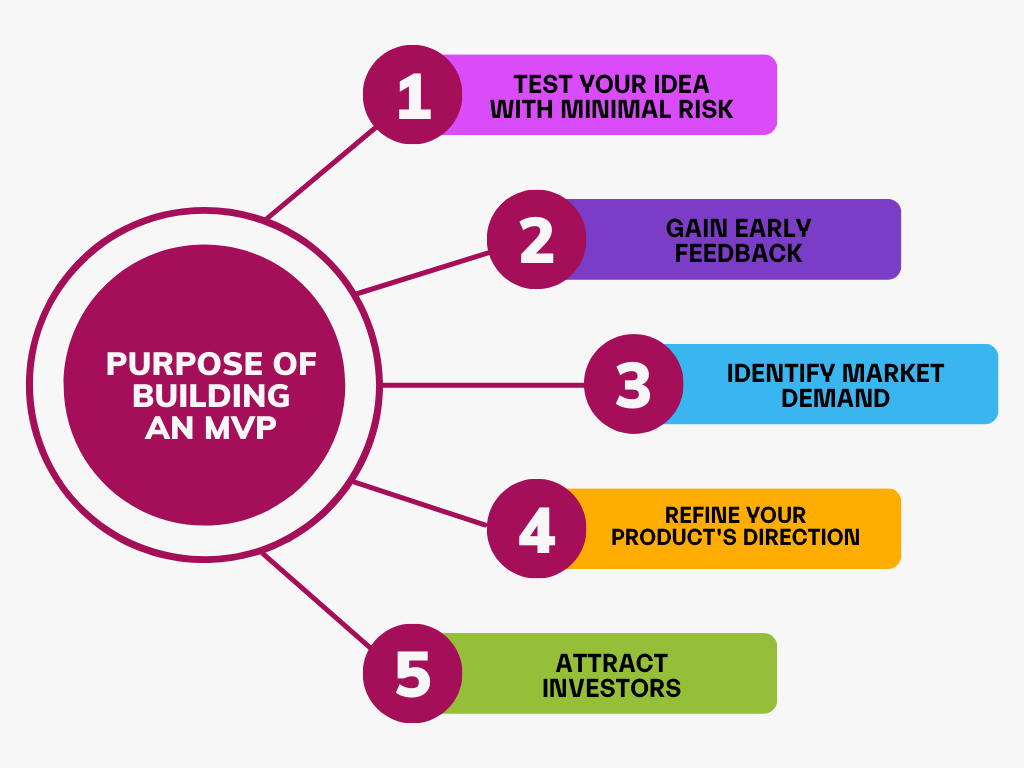
Let’s explore some of the key reasons why building an MVP is a crucial step in the product development process.
- Test your idea with minimal risk: Building an MVP allows you to test your product idea with real users without spending a lot of time and money on development. You can quickly determine if the core concept resonates with your target audience and if it’s worth pursuing further.
- Gain early feedback: Releasing an MVP to a small group of early adopters provides an opportunity to gather vital feedback on your product’s functionality, usability, and overall value proposition. This feedback can then be used to make iterative improvements to your product, ensuring it better meets the needs and expectations of your target market.
- Identify market demand: An MVP can help you gauge the level of demand for your product in the market. If your MVP gains traction and generates interest from users, it’s a strong indicator that there’s a market for your product, and you can confidently proceed with further development.
- Refine your product’s direction: By gathering user feedback and analyzing how your MVP performs in the market, you can identify areas where your product needs improvement or adjustments. This information can help you start refining your product’s direction, ultimately leading to a more successful final product.
- Attract investors: An MVP can also serve as a powerful tool for securing investment. By demonstrating that your product has traction and potential in the market, you’re more likely to convince investors of its viability and secure the funding you need for further development.
MVP vs. POC vs. Prototype
It’s essential to understand the differences between an MVP (Minimum Viable Product), POC (Proof of Concept), and a prototype, as each serves a distinct purpose in the product development process.
Let’s take a look at these three terms below and examine how they differ from one another.
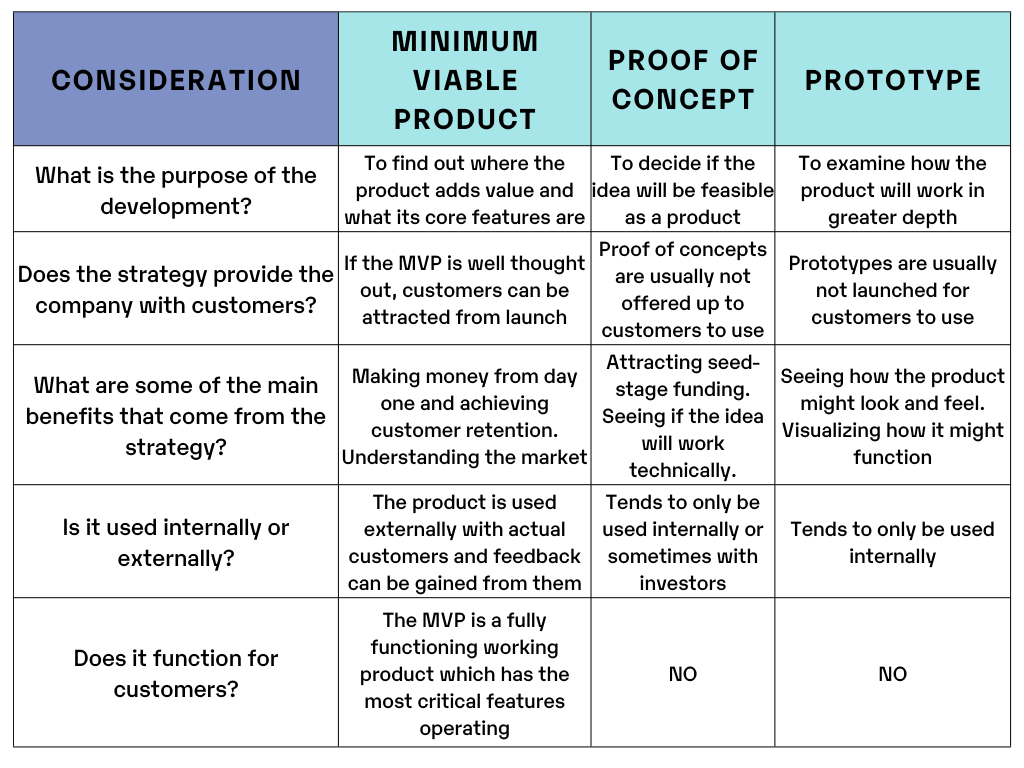
1. MVP (Minimum Viable Product)
As discussed earlier, an MVP is a scaled-down version of a product containing only the most critical features necessary for it to function. The primary goal of an MVP is to validate the product’s core concept, assess market demand, and gather user feedback to make data-driven decisions about the product’s future.
In essence, an MVP is a fully functional product that delivers value to its users, albeit with a limited feature set.
2. POC (Proof of Concept)
A POC is a demonstration or experiment designed to verify whether a specific idea or concept is feasible, usually from a technical perspective. The main objective of a POC is to establish that the proposed technology, methodology, or approach can work in practice.
Unlike an MVP, a POC is not a complete product but rather a test of a specific aspect or functionality to ensure it can be successfully implemented in the final product. POCs are typically conducted internally or with a small group of stakeholders and are not released to the public.
3. Prototype
A prototype is an early, often incomplete, representation of a product that allows you to visualize and explore its design and functionality. Prototypes can take many forms, from simple sketches to interactive digital models.
The primary purpose of a prototype is to test the product’s design, user interface, and user experience before moving on to the development stage. Unlike an MVP, a prototype may not be fully functional and is generally not made for public release.
Each of these stages plays a unique role in the product development process, helping you to make informed decisions, minimize risk, and ultimately create a successful product that meets the needs and expectations of your target market.
🎙️ Podcast
Examples of Minimum Viable Products
Many successful companies have used the MVP approach to validate their ideas and pave the way for full-scale product development.
Let’s take a closer look at some notable examples, such as Airbnb, Virgin Airlines, Dropbox, Facebook, and Uber, and how they started as MVPs before evolving into the well-established businesses they are today.
1. Airbnb
Airbnb’s journey began when its founders, Brian Chesky, and Joe Gebbia, were struggling to pay rent for their San Francisco apartment. They decided to create a simple website offering their living room as accommodation for attendees of a local design conference, providing an air mattress and breakfast.
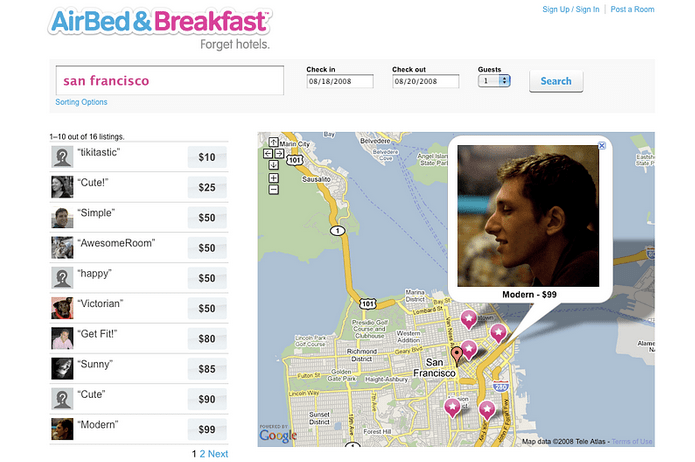
This MVP validated the idea that people were willing to stay in strangers’ homes as an alternative to traditional hotels. Over time, Airbnb evolved into a global platform for short-term rentals, with millions of listings globally.
2. Virgin Airlines
Richard Branson’s venture into the airline industry began when he was stranded at an airport due to a canceled flight. Frustrated, he chartered a private plane and offered the empty seats to other stranded passengers at a reasonable cost.
This impromptu MVP demonstrated that there was a demand for a customer-focused airline that provided a better travel experience. Virgin Airlines was born from this initial validation, growing into a successful international airline.
3. Dropbox
Dropbox’s MVP was a simple explainer video that showcased the core functionality of the file-sharing and syncing service. The video aimed to gauge interest in the product and see if potential users found value in the concept.
After the video was released, Dropbox’s waiting list grew from 5,000 to 75,000 users overnight, indicating a strong demand for the service. Dropbox then proceeded to develop the full product, which is now used by millions of people worldwide.
4. Facebook
Facebook started as a basic MVP called “Thefacebook,” developed by Mark Zuckerberg and his college roommates at Harvard University.
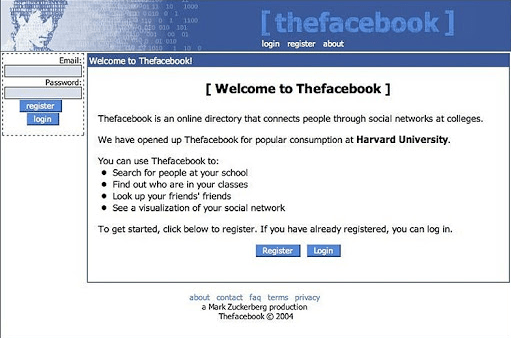
The initial platform allowed users to create profiles, add friends, and exchange messages within the Harvard community.
As the platform gained popularity within the university, it expanded to other educational institutions and eventually the general public. Today, Facebook is a global social media giant with billions of users.
5. Uber
Uber’s MVP was a simple app called “UberCab” that connected riders with drivers in San Francisco. The initial service was geared towards providing luxury car rides at the tap of a button, aiming to validate the idea of on-demand transportation through a smartphone app.
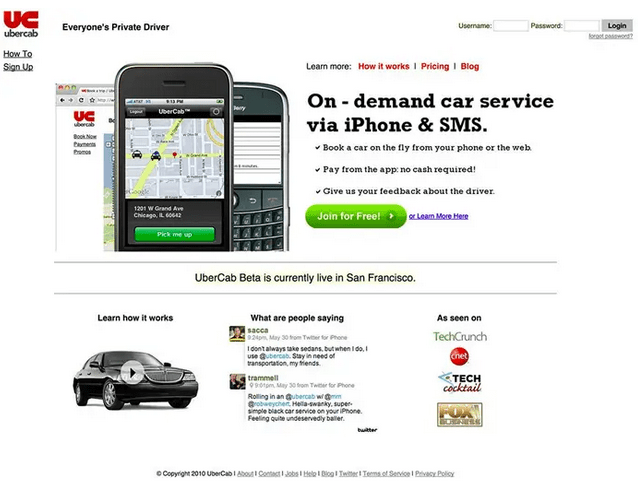
As the concept gained traction, Uber expanded its services to include various vehicle options at different price points, eventually becoming the global ride-sharing leader we know today.
These examples highlight the power of starting with an MVP to validate ideas and gather early feedback, and of course having a growth mindset and
Each of these companies began with a basic version of their product, focusing on core features and value propositions, and then iteratively improved and expanded their offerings based on market demand and user feedback.
This MVP approach allowed them to minimize risk and maximize the likelihood of success in their respective industries.
🎙️ Podcast
How to validate and bring SaaS ideas to $1k MRR with Shane White
Steps to Building an MVP
Developing an MVP involves several key steps to ensure that your product effectively addresses a genuine problem and offers a viable solution.
In this section, we will sketch out a 12-step process for building an MVP that you can follow to maximize your chances of success.
1. Define the Problem That Your MVP Will Solve
The first step in building an MVP is to identify the problem that your product aims to solve. This is crucial because the value of your product depends on its ability to address a specific pain point or fulfill a particular need for your target audience.
Start by conducting research on your target market, analyzing existing solutions, and talking to potential users to gain insights into the challenges they face. Once you have a clear understanding of the problem, you can begin to craft a solution that will resonate with your target audience and set your product apart from the competition.
2. Keep the Scope of Your MVP Small
When building an MVP, it’s essential to keep the scope of the project as small as possible. This means focusing on the core features and functionality that will directly address the problem you’ve identified while excluding any non-essential or “nice-to-have” elements.
The primary goal of an MVP is to validate your product’s core concept, so it’s crucial not to get bogged down by secondary features that may dilute the main value proposition.
To narrow down the scope of your MVP, make a list of all potential features and functionalities, and then prioritize them based on their importance to solving the problem at hand.
Focus on including only the most crucial features in your MVP, as this will enable you to launch your product faster, minimize development costs, and gather user feedback as soon as possible.
Keeping the scope small also helps you stay agile and adaptable. As you receive feedback from early adopters, you’ll likely need to make changes to your product based on their insights.
A smaller scope allows you to iterate more quickly and efficiently, ensuring your product evolves in the right direction while minimizing wasted time and resources.
3. Identify Your Core Value Proposition
The core value proposition is the unique selling point that sets your product apart from competitors and conveys the primary benefit it offers to users. Clearly defining your core value proposition is essential for creating an MVP that resonates with your target audience and demonstrates its potential to solve their problem.
To identify your core value proposition, ask yourself the following questions:
- What is the main problem my product aims to solve?
- How does my product address this problem in a way that existing solutions do not?
- What are the most compelling benefits my product offers to users?
By answering these questions, you can pinpoint the unique aspects of your product that differentiate it from competitors and create a strong value proposition that captures the essence of your MVP.
Once you’ve outlined your core value proposition, ensure that it’s consistently communicated throughout your MVP’s design, messaging, and marketing materials. This will help users understand the value of your product and reinforce its central purpose, making it more likely that they’ll engage with it and provide valuable feedback.
4. Build a Team of Experts
Assembling a team of experts is a crucial step in the development of a successful MVP, particularly for founders with limited technical knowledge. A well-rounded team will ensure that your MVP is built efficiently and effectively, while also providing valuable insights and guidance throughout the process.
Below are some key roles to consider when building your MVP team:
- CTO (Chief Technology Officer): A CTO with a strong technical background is essential for overseeing the development process and ensuring the MVP aligns with your vision.
It’s particularly beneficial if your CTO has a passion for teaching and sharing their knowledge. This will make it easier for you to learn from them, exchange ideas, and collaborate on the project, even if you lack technical expertise.
At Trustshoring, we offer leadership services for tech companies that lack a CTO helping you gain trustworthy and objective leadership throughout your MVP development phase and beyond.
- Software Developers: Skilled software developers will bring your MVP to life by translating your ideas into functional code. Depending on your product’s specific needs, you may require developers with expertise in different programming languages, technologies, or solutions like Software Testing, QA, etc.
- UI/UX Designers: User Interface (UI) and User Experience (UX) designers will help create a visually appealing and intuitive product that meets the needs of your target audience. Good design is critical for ensuring that users can easily understand and interact with your MVP.
- Product Manager: A product manager is responsible for coordinating the various aspects of the MVP development process, from feature prioritization to communication between team members. They ensure that the project stays on track and meets its goals.
- Marketing and Sales Specialists: These experts will help you define your target audience, craft messaging that effectively communicates your core value proposition, and develop strategies to attract users and generate feedback.
As a founder with little to no technical knowledge, it’s especially important to surround yourself with a team of experts who can provide the support and expertise needed to bring your MVP to life. This will not only help ensure the success of your MVP but also provide you with valuable learning opportunities that will benefit you as your product continues to grow and evolve.
Looking to hire a Full Stack Developer for your MVP? Get in touch with us today!
4. Identify Your Target Market
Understanding your target market is vital for the successful development and launch of your MVP. Identifying the specific group of users who are most likely to benefit from your product will help you tailor its features, design, and messaging to resonate with that audience, increasing the chances of adoption and valuable feedback.
To identify your target market, consider the following steps:
- Analyze the problem: Revisit the problem your MVP aims to solve and think about the types of users who are most likely to experience this issue. This may include individuals from specific age groups, industries, locations, or other demographic factors.
- Conduct market research: Gather data on the users you’ve identified to better understand their needs, preferences, and behaviors. This may involve analyzing industry reports, conducting surveys or interviews, or examining the competition to see which segments they are targeting.
- Create user personas: Develop detailed personas of your ideal users, outlining their demographics, needs, pain points, and preferences. These user profiles will help guide your MVP’s development and ensure that your product is tailored to the needs of your target audience.
- Evaluate market size: Assess the potential size of your target market by estimating the number of users who could benefit from your product. This will help you determine whether the market is large enough to support your business and justify the investment in developing your MVP.
- Test your assumptions: Validate your target market by engaging with potential users and gathering feedback on your MVP’s concept and core value proposition. This may involve sharing prototypes or mockups, conducting focus groups, or launching a beta version of your product to gauge interest and gather insights.
By identifying your target market, you can ensure that your MVP is developed with a clear focus on the users who are most likely to benefit from it.
This will help you create a product that addresses their specific needs, wants, and preferences, increasing the chances of a successful launch and valuable user feedback.
5. Identify Your Early Adopters
Early adopters are the first group of users who embrace your MVP and provide valuable feedback that helps shape its future development. These individuals are typically more willing to try new products and technologies, and their insights can be instrumental in refining your product, validating its core value proposition, and identifying areas for improvement.
To identify your early adopters, consider the following steps:
- Analyze your user personas: Revisit the user personas you developed when identifying your target market. Have a look at characteristics that indicate a higher likelihood of being open to trying new products, such as tech-savviness, a history of early adoption, or a strong need for the solution your MVP provides.
- Segment your target market: Divide your target market into smaller groups based on the characteristics that make them more likely to be early adopters. This may include factors such as industry, job role, or specific pain points that your MVP addresses.
- Craft targeted messaging: Develop messaging that speaks directly to the needs and interests of your early adopters. Highlight the unique benefits your MVP offers, and emphasize its potential to solve their specific problems.
- Leverage existing networks: Reach out to individuals or communities within your target market who are known for being early adopters or who have expressed interest in similar products. This may include industry influencers, bloggers, or online forums where your target audience is active.
- Create some incentives: Encourage early adoption by offering incentives such as exclusive access, discounted pricing, or the opportunity to influence the product’s development. These incentives can help attract early adopters and motivate them to provide valuable feedback on your MVP.
Identifying and engaging with early adopters is crucial for gathering the insights needed to refine your MVP and ensure it meets the needs of your target audience. By focusing on these users, you can maximize the value of their feedback and increase the likelihood of your MVP’s success.
6. Defining constraints
When developing your MVP, you’ve got to consider various constraints that can impact the project’s success. Taking these constraints into account will help you make better decisions, prioritize resources, and set realistic goals for your product’s development and growth.
Here are some key constraints to consider:
- Development stages: Consider the short-term (3-6 months), mid-term (1-2 years), and long-term (5 years and beyond) development goals for your product. Clearly defining your objectives for each stage will help you allocate resources appropriately, prioritize features, and set achievable milestones for your MVP.
In the short term, your focus should be on launching a functional MVP with the most critical features to validate your core value proposition.
In the mid-term, you may plan to enhance your MVP by incorporating user feedback, adding new features, and optimizing performance.
For the long term, your vision might involve expanding your product’s reach, entering new markets, or even pivoting the product’s focus based on the insights gained from earlier stages. By outlining clear objectives for each stage, you can better allocate resources and guide your team’s efforts in a more focused manner.
- Scalability: Think about the scale you want to achieve with your product and how this will influence the resources and efforts required to reach that goal. This includes factors such as user growth, infrastructure needs, and potential expansion to new markets or verticals.
From a technical standpoint, evaluate the infrastructure and architecture needed to support your product as it grows in terms of users, data, and features. This may involve implementing a scalable database, optimizing performance, or leveraging cloud-based solutions.
From a business perspective, you’ve got to consider how you will handle customer support, marketing, and sales as your user base expands.
You may need to develop strategies for customer acquisition and retention, hire additional team members, or form strategic partnerships to support your growth. Establishing a clear vision for your product’s scalability will help you make strategic decisions and plan for the future.
- Maturity level for the first release: Determine the level of maturity you expect from your MVP upon its initial release. This includes factors such as stability, performance, and feature completeness.
If you aim for a higher level of maturity, you may choose to invest more time in thorough testing, addressing potential edge cases, and refining the user experience.
On the other hand, if you’re comfortable with a lower level of maturity, like a prototype for example, you may prioritize speed-to-market and focus on delivering a basic, functional version of your product to gather feedback quickly. It’s crucial to strike a balance between the level of maturity and the need to launch your MVP in a timely manner.
Defining the desired maturity level will guide your development process and help you decide which features to prioritize for the first release.
- Timeline and budget constraints: Developing a realistic timeline involves considering factors such as team capacity, technical complexity, and potential risks or roadblocks.
Break down your project into smaller tasks, estimate the time required for each, and allocate buffer time for unforeseen challenges. Similarly, when it comes to budgeting, consider the costs associated with development, design, marketing, and other aspects of your MVP.
Prioritize your spending based on your goals and constraints, and be prepared to make trade-offs if necessary.
Defining these constraints helps you create a product that meets the needs of your target audience while adhering to your project’s limitations.
7. Defining the right technology
Choosing the right technology for your MVP will impact the product’s performance, scalability, and overall user experience. All these factors will affect its success.
Web development frameworks: Web development frameworks can significantly speed up the development process by providing pre-built components and a structured approach to building web applications.
These frameworks follow best practices, offer extensive documentation, and are backed by active developer communities, making it easier to build and deploy your MVP quickly
Front-end frameworks and libraries: Front-end frameworks and libraries like HTML, CSS, JavaScript, Angular, and Vue.js can help you create a responsive and visually appealing user interface for your MVP. These tools provide reusable components, simplify the development of complex UI elements, and ensure cross-browser compatibility, which can save time and effort during the development process.
Mobile app development platforms: For MVPs that require a mobile app, platforms such as React Native, Flutter, and Xamarin can streamline the development process.
These cross-platform development tools enable you to build apps for both iOS and Android using a single codebase, reducing the time and resources required to create separate apps for each platform.
Backend technologies: Here you’ve got technologies like Node.js with Express.js – A fast and minimalist web framework for Node.js, ideal for building simple and scalable server-side applications.
Looking to hire a Laravel developer for your back-end needs? Get in touch with us today!
Flask, which is a lightweight Python web framework that is easy to learn and use, perfect for small-scale projects or MVPs, and Ruby on Rails, which is a web application framework for the Ruby programming language that promotes rapid development and clean, pragmatic design.
At Trustshoring we can help you hire a Ruby on Rails developer with the right experience that matches your exact development needs.
Backend-as-a-Service (BaaS) and Platform-as-a-Service (PaaS): BaaS and PaaS solutions, such as Firebase, Heroku, and AWS Amplify, can simplify backend development and deployment by providing pre-built infrastructure and services.
These platforms allow you to focus on building your MVP’s core features without worrying about server setup, database management, or scalability.
No-code and low-code platforms: As mentioned earlier, no-code and low-code platforms like Bubble, OutSystems, or Adalo can enable rapid MVP development with minimal coding.
These platforms provide drag-and-drop interfaces and pre-built components, allowing you to design, build, and deploy your MVP without extensive technical knowledge. However, be mindful of the potential limitations in customization and scalability when using these platforms.
By leveraging these development technologies, you can accelerate the MVP development process and launch your product more quickly.
Are you looking to hire a .Net Developer? Get in touch with us today!
It’s essential to evaluate each technology based on your MVP’s specific requirements and your team’s expertise to select the most suitable solution for your project.
When determining the best technology for your MVP, consider the following factors:
- Align with targets, goals, and constraints: Assess the specific requirements of your MVP, including its intended functionality, scalability, and performance goals. Additionally, take into account your budget and timeline constraints.
Choose technologies that align with these factors and allow you to achieve your desired outcomes without exceeding your limitations.
- Evaluate the ease of development and maintenance: Opt for technologies that offer a straightforward development process, a strong developer community, and comprehensive documentation. This will facilitate faster development, easier problem-solving, and more efficient maintenance in the long run.
- Consider compatibility and integration: Ensure that the chosen technology stack is compatible with any existing systems or tools you plan to integrate with your MVP. This will simplify the integration process and minimize potential roadblocks.
- Taking advantage of Low-code platforms: As we mentioned earlier, low-code platforms can offer a fast option for development at a much lower cost. These platforms enable rapid application development with minimal coding, allowing you to build and launch your MVP quickly. However, keep in mind that low-code solutions may have limitations in terms of customization and scalability.
- Utilizing existing products: To save time and resources, consider leveraging existing products or tools as part of your MVP. This may involve using third-party APIs, software libraries, or pre-built components to streamline the development process and reduce the need for custom coding.
- Manual MVPs: In some cases, it may be feasible to create a manual MVP, also known as a “concierge MVP” or “wizard of oz MVP.” This approach involves manually performing tasks that will eventually be automated by your fully fledged product, allowing you to validate your core value proposition and gather user feedback with minimal upfront investment in technology.
By carefully evaluating your MVP’s requirements, you will ensure that your MVP is built efficiently and effectively, while also positioning it for future growth and success.
8. Creating a solid product concept and documentation
The next step is to create a well-defined product concept and comprehensive documentation.
This step ensures that everyone on your team has a clear understanding of the MVP’s goals, features, and requirements, which can prevent misunderstandings, streamline the development process, and improve the overall quality of your product.
Here are some key aspects to consider when creating your product concept and documentation:
- Clearly define your MVP’s objectives: Establish the specific goals your MVP aims to achieve, such as validating a core value proposition, testing a new market, or acquiring early adopters. This will help you and your team maintain focus on what matters most throughout the development process.
- Create a feature list: Develop a list of features that will be included in your MVP, prioritizing those that directly address the core value proposition and are essential to the user experience. Be selective and resist the temptation to include too many features, as this can lead to scope creep and delays in development.
- Develop user stories and use cases: Write user stories and use cases that describe how different types of users will interact with your MVP. This will help your team better understand the intended functionality and user experience and provide a solid foundation for the development process.
- Create wireframes and mockups: Design wireframes and mockups for your MVP to provide a visual representation of the user interface and layout. This will help your team and all the stakeholders involved, get a clear picture of what the final product will look like and enable them to provide feedback before development begins.
- Develop technical documentation: Prepare detailed technical documentation, including database schema, API specifications, and system architecture diagrams. This will provide your development team with the necessary guidance and ensure that everyone is on the same page regarding the technical requirements and implementation.
- Establish a project plan and timeline: Develop a project plan that outlines the development process, including milestones, deliverables, and deadlines. This will help your team stay on track, manage expectations, and ensure that your MVP is delivered within the desired timeframe.
By creating a solid product concept and comprehensive documentation, you can ensure that your team has a shared understanding of the MVP’s goals and requirements.
9. Eliminate Technical Risks
By identifying and addressing potential issues early on, you can prevent costly delays, unexpected challenges, and inefficiencies that could jeopardize the success of your MVP.
How can you minimize technical risks and improve the accuracy of your project estimates?
- Define a clear project scope: Establish a well-defined scope for your MVP, outlining the features and functionalities that are essential for addressing the core value proposition. A clear scope will prevent scope creep and help you create accurate project estimates.
- Conduct thorough research: Investigate the technology landscape, exploring different options and their suitability for your MVP. Understand the benefits and drawbacks of each technology, and select the ones that best align with your project requirements and constraints.
- Engage subject matter experts: Consult with technical experts or hire experienced team members who can help identify potential risks and recommend the best solutions. Their insights will be invaluable in mitigating technical risks and ensuring accurate estimates.
- Develop a risk management plan: Identify potential risks, their likelihood, and the potential impact on your project. Develop strategies to mitigate these risks and include contingency plans for unforeseen challenges.
- Break down tasks and estimate time: Divide the project into smaller, manageable tasks, and estimate the time required for each. Allocating buffer time for unforeseen challenges will help ensure a more accurate overall estimate.
- Implement a flexible development methodology: Adopt an agile development methodology, which allows for ongoing adjustments and improvements as you identify and address technical risks throughout the development process.
- Conduct regular reviews and assessments: Schedule periodic reviews and assessments to evaluate progress, identify potential technical risks, and adjust your plans accordingly. This will help you stay on track, manage expectations, and ensure that your estimates remain reliable.
- Foster open communication: Encourage open and transparent communication within your team, ensuring that any technical risks or challenges are shared and addressed promptly. This collaborative approach will help you stay agile and adapt to any changes or unforeseen issues.
- Test early and often: Implement a rigorous testing strategy to catch potential issues before they escalate. Regular testing will help you identify and resolve technical risks early, ensuring smoother development and more accurate estimates.
- Learn from past experiences: Reflect on previous projects and identify any lessons learned regarding technical risks and challenges. Incorporating these insights into your current project will help you avoid repeating past mistakes and improve the reliability of your estimates.
10. Plan for Feedback
Gathering feedback is a crucial aspect of MVP development, as it helps you validate your assumptions, identify areas for improvement, and iterate on your product.
So how do you go about gathering feedback and ensuring the success of your MVP?
- Identify your target audience: Clearly define the group of users that your MVP aims to serve. These users should be representative of your target market and the early adopters who will be most likely to provide valuable feedback.
- Develop a feedback strategy: Establish a plan for gathering feedback from your target audience. This could involve conducting surveys by using survey tools, focus groups, user interviews, or utilizing in-app analytics tools. Determine which methods will be most effective for your specific MVP and audience.
- Create a feedback loop: Implement a continuous feedback loop that allows you to gather user insights, analyze the data, and iterate on your MVP. This agile approach will enable you to make data-driven decisions and ensure that your product remains aligned with user needs and expectations.
- Prepare your team for feedback: Encourage a culture of openness and receptiveness to feedback within your team. Emphasize the importance of learning from user insights and using them to improve your MVP. Establish clear roles and responsibilities for gathering and analyzing feedback.
- Set up a feedback collection system: Implement tools and platforms for collecting user feedback. This could involve integrating survey tools, analytics software, or in-app feedback mechanisms. Ensure that your system is easy to use and allows users to provide feedback effortlessly.
- Communicate with users: Engage with your target audience throughout the development process, keeping them informed about your progress and inviting them to share their thoughts and opinions. This ongoing communication will help build trust and encourage users to provide honest feedback.
- Analyze and prioritize feedback: Collect and analyze user feedback to identify patterns, trends, and areas of concern. Prioritize the feedback based on its potential impact on your MVP and the value it offers to users. Focus on addressing the most critical issues and opportunities for improvement.
- Iterate and improve: Use the feedback to refine your MVP, making necessary changes and improvements based on user insights. Continuously test and evaluate the impact of these changes, ensuring that your product evolves to meet user needs and expectations.
- Share updates and progress: Keep your users informed about the changes you’re making based on their feedback. This transparency will demonstrate your commitment to addressing their concerns and help maintain their engagement with your product.
- Learn and adapt: Continuously learn from the feedback you receive and adapt your product, development processes, and strategies accordingly. This growth mindset will ensure the ongoing success of your MVP and lay the foundation for a scalable and sustainable product.
11. Be Prepared to Pivot
Pivoting is the process of making significant changes to your business model, product, or strategy based on the feedback, data, and insights you’ve gathered during the development of your MVP.
Being prepared to pivot is crucial for the success of your startup, as it allows you to adapt and evolve in response to market demands and customer needs.
Importance of being prepared to pivot:
- Market demands: The market and customer preferences can change rapidly, and startups need to be agile and responsive to stay competitive. Being prepared to pivot ensures that your startup remains in the best position to capitalize on new opportunities.
- Learning from feedback: As you gather feedback from your users, you may discover that some assumptions about your product or target audience were incorrect. Being prepared to pivot allows you to adjust your approach based on these insights and better align with user needs.
- Mitigating risks: Pivoting can help you mitigate potential risks associated with a particular strategy or product feature, ensuring the long-term viability and success of your startup.
Signs of a need to pivot:
- Poor user engagement: If your MVP is not attracting users or they’re not engaging with your product as expected, it could be a sign that you need to pivot and rethink your value proposition or target audience.
- Limited market potential: If you discover that your target market is smaller than initially anticipated or not growing as expected, it might be time to pivot to a more lucrative market segment or expand your product offerings.
- Inability to differentiate: If your MVP doesn’t stand out from the competition, it might be an indication that you need to pivot and explore a unique selling proposition or niche market.
- Insufficient revenue: If your MVP isn’t generating enough revenue to support the growth and sustainability of your startup, pivoting to a new business model or monetization strategy may be necessary.
How do you pivot?
- Analyze data and feedback: Review the feedback and data collected during your MVP development and identify the areas where your product or strategy is underperforming. Look for patterns and trends that can inform your pivot decision.
- Assess your options: Explore alternative strategies, business models, or product features that could address the issues you’ve identified. Conduct market research to validate the viability and potential of these new approaches.
- Develop a pivot plan: Outline the steps required to pivot, including changes to your product, team, and resources. Establish clear goals and objectives for the pivot, as well as a timeline for implementation.
- Communicate with stakeholders: Keep your team, investors, and users informed about the pivot and the reasons behind it. This transparency will help build trust and maintain support during the transition.
- Test and iterate: Implement the pivot and monitor its impact on your startup’s performance. Gather feedback and data to continuously refine and optimize your new strategy, product, or business model.
By recognizing the signs of a need to pivot and implementing a strategic pivot plan, you can ensure the long-term success and growth of your startup.
12. Lastly, Build, Measure, Learn and Improve
The final stage in developing your MVP involves embracing the iterative process of building, measuring, learning, and improving. This approach ensures that your product continuously evolves to meet the needs of your target audience and remains competitive in the marketplace.
Build:
Develop your MVP: Create your minimum viable product based on the insights and planning you’ve conducted throughout the development process. Focus on the core features and value proposition that will resonate with your target audience.
Launch your MVP: Release your MVP to a select group of early adopters or your target market. This launch will serve as an opportunity to gather initial feedback and test your assumptions about product-market fit.
Measure:
Collect data and feedback: Use various tools and methods to gather quantitative and qualitative data about your MVP’s performance. This can include user feedback, in-app analytics, surveys, focus groups, and user interviews.
Analyze results: Assess the data and feedback you’ve collected to identify trends, patterns, and areas for improvement. Determine whether your MVP is meeting the needs of your target audience and delivering on its value proposition.
Learn:
Identify insights: Conclude the data and feedback analysis to gain insights into the strengths and weaknesses of your MVP. Identify any areas where your assumptions were incorrect or where user expectations were not met.
Adjust your strategy: Based on the insights you’ve gained, make strategic adjustments to your product, target audience, or business model. This might involve pivoting, refining your value proposition, or adding new features.
Improve:
Implement changes: Apply the learnings from your analysis to make improvements to your MVP. This can include updating features, refining the user experience, or addressing any identified issues.
Test and iterate: Continuously test the impact of the changes you’ve made and gather additional data and feedback. Iterate on your MVP as needed to ensure it continues to evolve and meet the needs of your target audience.
This iterative approach will help your startup adapt to changing market conditions, user preferences, and new opportunities, ultimately laying the foundation for long-term success and growth.
Measuring Success After Building an MVP
Congratulations! Your MVP is now built, and you can now start gauging and taking a look at the fruits of your labor.
In this section, we’ll discuss several key indicators that can help you gauge the success of your MVP:
Word of mouth
Word of mouth is a powerful indicator of your MVP’s success, as it shows that your users are satisfied with your product and willing to recommend it to others.
Positive word of mouth can drive organic growth, reduce marketing costs, and build trust in your product. Monitor online reviews, social media mentions, and direct referrals to assess the extent of word of mouth surrounding your MVP.
Engagement
User engagement is a crucial measure of your MVP’s success. High engagement levels indicate that users find value in your product and are actively using it.
Track metrics such as time spent on your platform, the number of sessions per user, and feature usage to gain insights into user engagement. Low engagement levels may signal a need to reevaluate your value proposition or make improvements to your product.
Sign-ups
The rate at which users sign up for your product is another key indicator of your MVP’s success. A high sign-up rate demonstrates that your product is resonating with your target audience and has the growth potential. Monitor the number of new sign-ups, conversion rates, and the sources of your sign-ups to identify trends and opportunities for growth.
Better Client Appraisals Based on the Feedback
Positive feedback and appraisals from clients are vital signs of a successful MVP. This feedback can provide valuable insights into the aspects of your product that users find most valuable and areas where improvements can be made. Collect and analyze client feedback to identify patterns and trends, and use these insights to inform your product development strategy.
Percentage of Active Users
The percentage of active users is a measure of your MVP’s ability to retain users and keep them engaged over time. A high percentage of active users indicates that your product is meeting the needs of your target audience and providing ongoing value. Track metrics such as daily active users, monthly active users, and user retention rates to assess the success of your MVP in maintaining an active user base.
By monitoring these key indicators, you can effectively measure the success of your MVP and identify areas for improvement. Use this data to inform your product development strategy and ensure that your MVP continues to evolve and meet the needs of your target audience.
Conclusion
Building a successful MVP is a critical step for SaaS founders seeking to launch a product that addresses a genuine market need while conserving resources.
By following a methodical process that includes defining the problem, keeping the scope small, identifying the core value proposition, assembling the right team, and embracing the build-measure-learn-improve cycle, founders can develop an MVP that validates their idea and pave the way for long-term success.
Measuring the success of your MVP is equally important, as it provides insights into the effectiveness of your product and helps identify areas for improvement.
Monitoring key indicators such as word of mouth, engagement, sign-up rates, client feedback, and the percentage of active users will ensure that your MVP continues to evolve and meet the needs of your target audience.
By staying agile and responsive to user feedback and market demands, you can successfully navigate the startup journey and build a product that delivers lasting value.
At Trustshoring we help businesses plan for their MVP by offering technical advice, and guidance – Connecting you to a team of developers who match both your vision and business needs.
Are you ready to build your MVP and validate your Idea? Get in touch with us today!
Read more
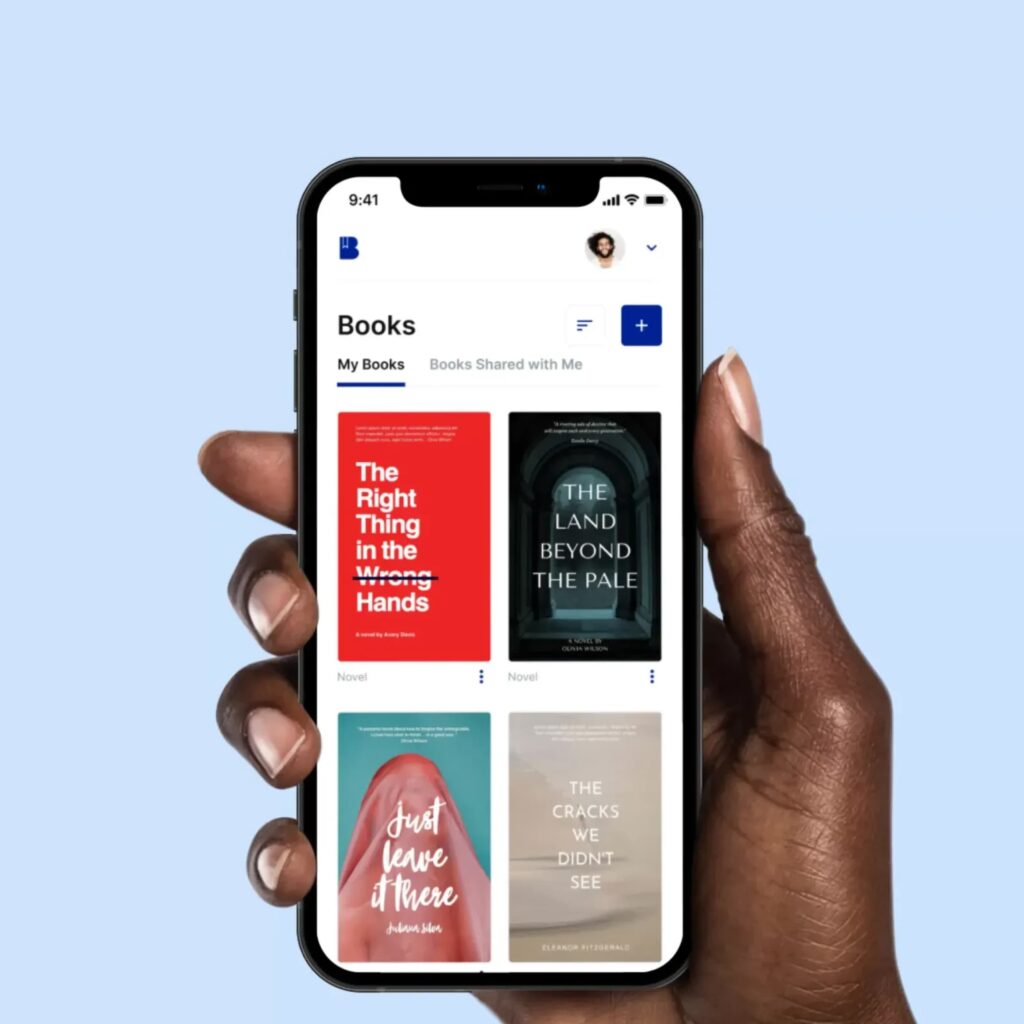

Case study:
Blooksy
Learn how Blooksy moved from concept and raised funding!

The Possibilities with ChatGPT and How to Use It in Your SaaS

When You Need a Technical Co-Founder and When You Don’t

Protecting Intellectual Property: Best Practices in Document Security for SAAS

What Makes Software Development Expensive & Unpredictable?
Create a free plan for growth
Speak to Victor and walk out with a free assessment of your current development setup, and a roadmap to build an efficient, scalable development team and product.
“Victor has been great. Very responsive and understanding and really knows his stuff. He can go the extra mile by tapping into his prior experiences to help your company out. Really enjoyed working with him.”
Founder of Agency360

Victor Purolnik
Trustshoring Founder
Author, speaker, and podcast host with 10 years of experience building and managing remote product teams. Graduated in computer science and engineering management. Has helped over 300 startups and scaleups launch, raise, scale, and exit.